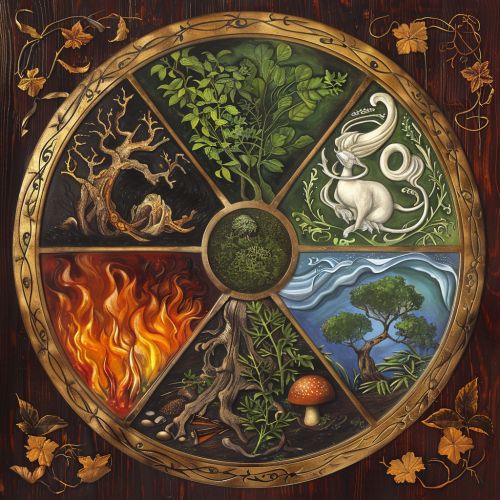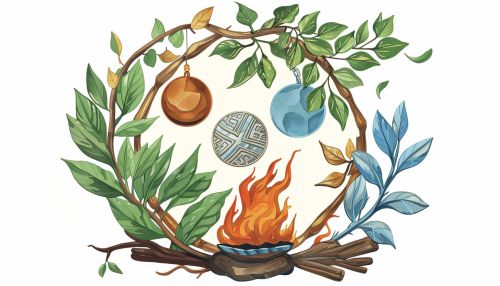Five elements (Chinese philosophy)
Introduction
The Five Elements (五行, Wǔ Xíng), also known as the Five Phases, Five Agents, Five Movements, Five Processes, and Five Steps/Stages, is a conceptual scheme in Chinese philosophy used to describe the interactions and relationships between phenomena. The Five Elements are Wood (木, Mù), Fire (火, Huǒ), Earth (土, Tǔ), Metal (金, Jīn), and Water (水, Shuǐ). This system is integral to various forms of traditional Chinese thought, including medicine, astrology, feng shui, martial arts, and music.
Historical Background
The Five Elements theory has its roots in ancient Chinese cosmology and philosophy. It was first systematically described in texts from the Warring States period (475–221 BCE), such as the "Zhouyi" (周易) and the "Lüshi Chunqiu" (吕氏春秋). The theory was further developed during the Han Dynasty (206 BCE–220 CE), particularly in the works of scholars like Dong Zhongshu (董仲舒), who integrated it with Confucianism.
The Elements and Their Characteristics
Wood (木, Mù)
Wood represents growth, vitality, and flexibility. It is associated with the spring season, the east direction, and the color green. In traditional Chinese medicine (TCM), Wood is linked to the liver and gallbladder, as well as the eyes and tendons. Wood's energy is expansive and outward-moving, symbolizing creativity and birth.
Fire (火, Huǒ)
Fire symbolizes heat, transformation, and dynamic energy. It corresponds to the summer season, the south direction, and the color red. In TCM, Fire is connected to the heart and small intestine, as well as the tongue and blood vessels. Fire's energy is upward-moving, representing passion and action.
Earth (土, Tǔ)
Earth signifies stability, nourishment, and balance. It is associated with the late summer or the transitional periods between seasons, the center direction, and the color yellow. In TCM, Earth is linked to the spleen and stomach, as well as the mouth and muscles. Earth's energy is stabilizing and grounding, symbolizing nurturing and support.


Metal (金, Jīn)
Metal represents structure, rigidity, and clarity. It corresponds to the autumn season, the west direction, and the color white. In TCM, Metal is associated with the lungs and large intestine, as well as the nose and skin. Metal's energy is contracting and inward-moving, symbolizing precision and introspection.
Water (水, Shuǐ)
Water symbolizes fluidity, adaptability, and depth. It is linked to the winter season, the north direction, and the color black. In TCM, Water is connected to the kidneys and bladder, as well as the ears and bones. Water's energy is downward-moving, representing wisdom and reflection.
Interactions and Cycles
The Five Elements interact through two primary cycles: the Generative (Shēng, 生) cycle and the Controlling (Kè, 克) cycle.
Generative Cycle (Shēng, 生)
In the Generative cycle, each element generates or nourishes the next:
- Wood feeds Fire.
- Fire produces Earth (ash).
- Earth bears Metal.
- Metal enriches Water (minerals).
- Water nourishes Wood.
This cycle represents growth, support, and harmonious relationships.
Controlling Cycle (Kè, 克)
In the Controlling cycle, each element controls or restrains another:
- Wood parts Earth (roots breaking soil).
- Earth dams Water.
- Water extinguishes Fire.
- Fire melts Metal.
- Metal chops Wood.
This cycle represents regulation, balance, and checks and balances.
Applications in Traditional Chinese Medicine (TCM)
In TCM, the Five Elements theory is used to understand the human body's physiological activities and pathological changes. Each element is associated with specific organs, tissues, emotions, and sensory organs. For example, the liver (Wood) is linked to anger, the heart (Fire) to joy, the spleen (Earth) to worry, the lungs (Metal) to grief, and the kidneys (Water) to fear.
Practitioners use the Five Elements to diagnose and treat illnesses by identifying imbalances and restoring harmony among the elements. Techniques such as acupuncture, herbal medicine, and dietary therapy are employed to achieve this balance.
Applications in Feng Shui
Feng Shui, the ancient Chinese art of placement and arrangement, also relies on the Five Elements theory. Practitioners use the elements to create harmonious living and working environments. Each element is associated with specific shapes, colors, and materials, which are strategically placed to enhance the flow of Qi (energy) and promote well-being.
For example, Wood is represented by tall, columnar shapes and green colors, while Metal is symbolized by round shapes and white or metallic colors. The careful arrangement of these elements can influence various aspects of life, including health, wealth, and relationships.
Applications in Martial Arts
The Five Elements theory is integral to many traditional Chinese martial arts, such as Xingyiquan (形意拳). In Xingyiquan, each element corresponds to a specific fighting technique or strategy:
- Wood: Crushing (Pī, 劈)
- Fire: Exploding (Bēng, 崩)
- Earth: Drilling (Zhuān, 钻)
- Metal: Splitting (Pào, 炮)
- Water: Crossing (Héng, 横)
These techniques are practiced to develop physical and mental attributes, such as strength, speed, and adaptability. The interplay of the elements in combat mirrors their natural interactions, providing a philosophical framework for martial training.
Applications in Music
In traditional Chinese music, the Five Elements theory is used to classify musical instruments and compositions. Each element is associated with specific sounds, tones, and instruments:
- Wood: String instruments (e.g., guqin, pipa)
- Fire: Percussion instruments (e.g., drums, bells)
- Earth: Wind instruments (e.g., flute, sheng)
- Metal: Brass instruments (e.g., trumpet, gong)
- Water: Plucked instruments (e.g., zither, harp)
Composers use the elements to create balanced and harmonious pieces, reflecting the natural order and cycles of the universe.
Philosophical Significance
The Five Elements theory is not merely a system of classification but a dynamic model of change and transformation. It emphasizes the interconnectedness of all things and the constant flux of the natural world. This perspective encourages a holistic approach to understanding and interacting with the environment, promoting balance and harmony in all aspects of life.
